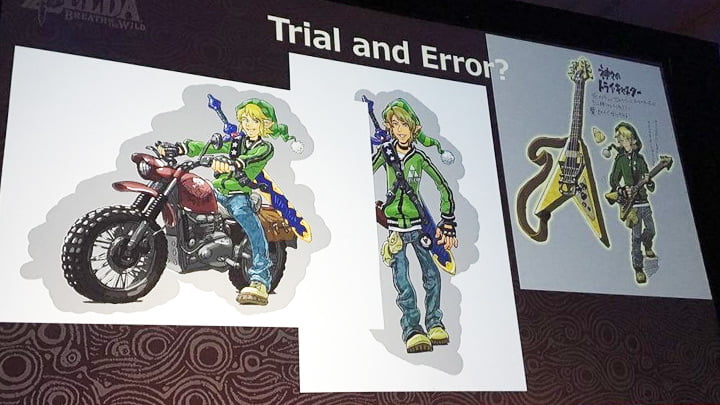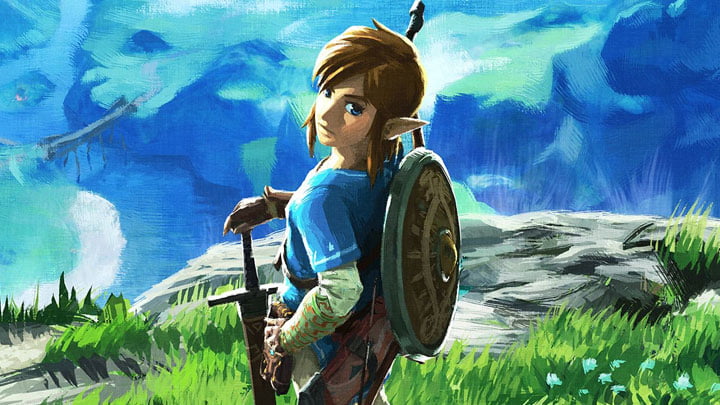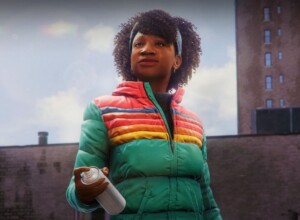Speaking at GDC, Nintendo’s Satoru Takizawa revealed how the artistic direction of The Legend of Zelda: Breath of the Wild was influenced by the game’s mechanics and convention-breaking design.
This is the third in our three-part report on the Breath of the Wild session from GDC 2017. The 90 minute talk was an extremely in-depth examination of the many decisions the development team made in creating Link’s latest adventure, so we’ve broken our coverage into three parts to ensure we cover as much of the detail as possible.
Satoru Takizawa, art director on Breath of the Wild, has contributed to every 3D game in The Legend of Zelda series. In approaching the latest title in the long-running series, Takizawa and his team explored a number of varied styles before finally deciding upon an artistic direction for the game.
By know you will have seen the outlandish concepts the team toyed with in planning for Breath of the Wild. Hyrule Wars, Zelda: Invasion, Guitar Link, Biker Link, and so on. How many of these were ever serious suggestions is open to debate, but they do demonstrate that Nintendo were prepared to tear up the rule book for the new Zelda game and break with the conventions of the past.

Referring to technical director Takuhiro Dohta’s concept of telling lies with game design, Takizawa spoke about the direct influence this had on the aesthetics of Breath of the Wild.
“In order to meet this challenge the artists had to continually research for an art style that makes it easy to lie,” says Takizawa. “It’s an art style that suits the game, while fulfilling the playability demands and without losing a feeling of reality.”
According to Takizawa, it’s the pleasantness of behaviours and visuals based on gameplay that will ensure the success of any chosen artistic approach.
“For a game, the optimisation of the pleasantness of the game cycle response is the most important thing. A reality players can sink in to,” he says.
“As as you move further away from realness, both tempo and visibility improve, and the level of pleasantness increases, but the reality of the world is also apt to be lost. That being said, if you place too much importance on the realness of the behaviour and presentation, you can damage a pleasant game cycle and responsiveness.”
Takizawa had to find an art direction that made these two components compatible, and a style that made it easy to lie.
The process of bringing The Wind Waker and Twilight Princess to Wii U was instrumental in this. The Wind Waker‘s assets in particular impressed the art team, having stayed original and fresh, even after ten years. It was also a style that allowed for the construction of a unique reality; one with which it was easy to lie and still guarantee playability.
The decision to follow in Wind Waker‘s footsteps was readily agreed upon in consultation with Breath of the Wild’s producer, Eiji Aonuma, and director, Hidemaro Fujibayashi. This led to the art team choosing an official slogan for the game’s artistic direction,
Refreshing and full-flavoured.
“This is the very important art creation slogan we adopted for Breath of the Wild,” says Takizawa. “In Japan I think a lot of people would hear this and want to have a beer!”
There were some problems with directly using the Wind Waker‘s art style, however.
“An important point in Mr. Fujibayashi’s game concept was to fill the vast game world with multiplicative game experiences using physics and chemistry gameplay. And this was difficult to achieve with the Wind Waker HD art style,” admits Takizawa.
“The Wind Waker HD art style, in its depiction of form and feel of materials, is very stylised. One of our goals was to have the art intuitively suggest possible physics and chemistry gameplay based on the player’s own experiences in the real world.”
The Wind Waker style simply told lies that were too big, says Takizawa, and that wasn’t the only hurdle to overcome.
“The concern was that if an older player could look at the screen for just an instant and understand everything they were seeing, they might feel the art was intended for children, and was not for them,” says Takizawa.
The challenge was in suggesting things players could do in the real world – which required an information-dense approach and a certain level of realism – but also retain a sense of clarity and colour.
“Our goal in supporting these elements equally led to ‘refreshing and full-flavoured,” says Takizawa.
This process resulted in an art style for Breath of the Wild that is a natural evolution of the Wind Waker’s toon aesthetics, and a treatment that also reflects an older, more experienced, Link.

To communicate the game’s multiplicative mechanics, some elements deliberately avoided realism, however. For example, if you break a log in the game, it instantly becomes a bundle of tied-up firewood, while food bounces around a cooking pot like a rubber ball.
“Streamlined tempo and event presentation was necessary to efficiently present Breath of the Wild’s game tempo and game cycle,” says Takizawa.
Although this presentation is not realistic, the abstraction actually connects the multiplicative gameplay, and physics and chemistry engines, in a simple, and sometimes comedic, way.
“When all the poofs [of smoke] and dancing food stuffs are implemented I didn’t feel the absurdity of it, but rather, the fun of it,” says Takizawa.
“It was the moment I felt we had come up with the answer I felt this game needed in its art style.”






